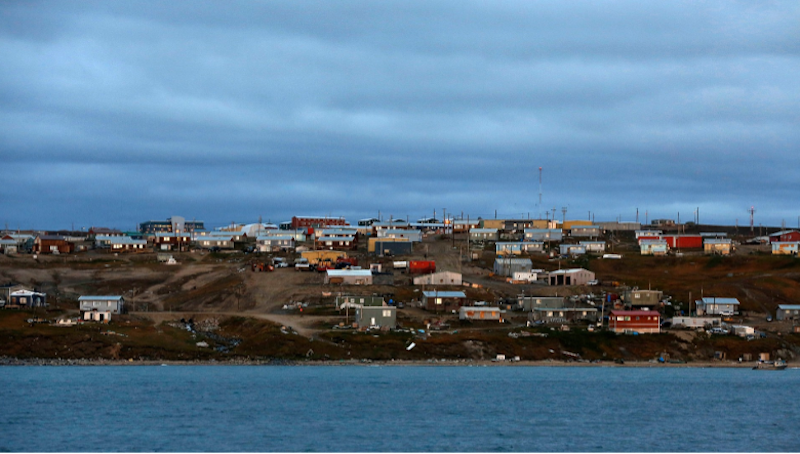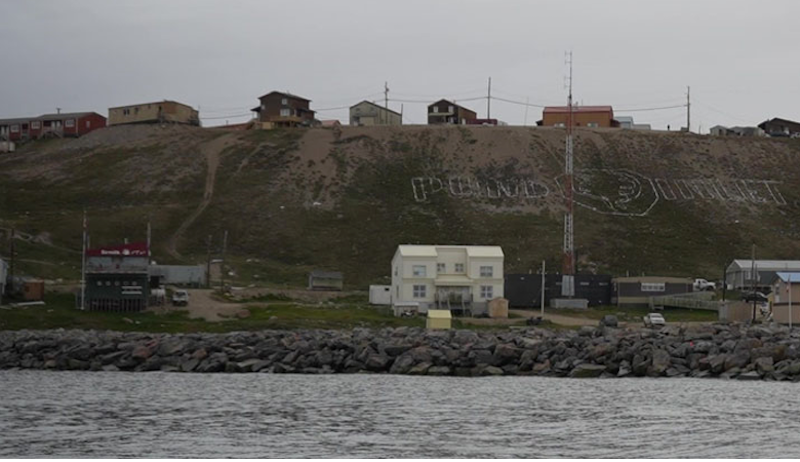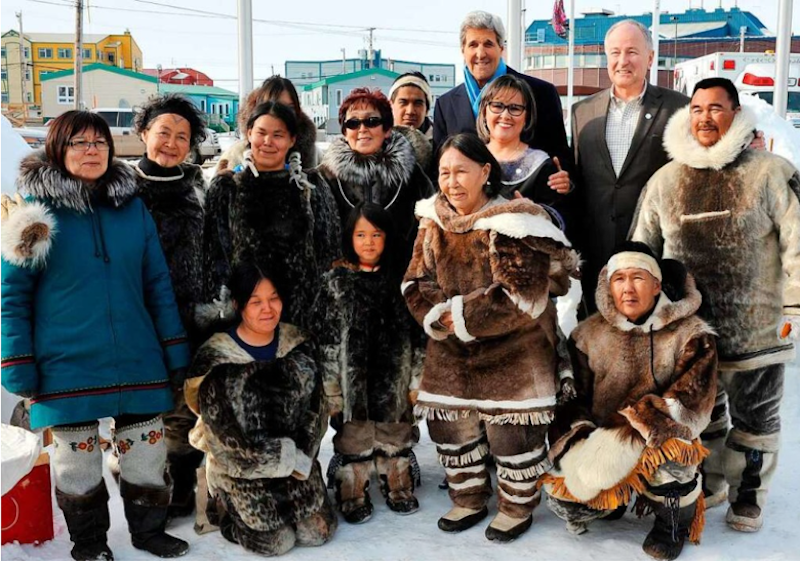Arctic by RIB - Episode 15 - Plan B for the Northwest Passage

Within minutes our psychology reversed. We left behind the negative energy of our multiple days of indecision and the explorer hidden inside us prevailed again. We mapped a course for Pond Inlet.
The Northwest Passage is an epic seaway north of Canada and Alaska, some 5,780 kilometers long (3,592 SM) connecting the Atlantic and Pacific oceans. It has been one of the most dangerous passages on the planet, with a history of shipwrecks and missing sailors.
For centuries, skilled sailors such as Henry Hudson and James Cook failed to cross it. Harsh weather, thick ice and invisible reefs forced many expeditions to turn back. A very prominent expedition which ultimately turned into tragedy was that of British officer John Franklin in 1845. The remains of his two ships were only recently found. (See the Introduction to this series for more information on the history of the NW Passage saga.)
But the risk only added to our excitement of at last getting a shot.
DAY 39th - Wednesday, August 10
The weather throughout Baffin Bay was so good that it seemed we could turn our bow wherever we wanted. Grise Fjord might still be frozen, but the path to Pond Inlet, some 340 NM away on Canada’s coast, looked clear. The major risk was that once there, ice could block us and we would have to make our way back—after first finding adequate fuel in that remote outpost.
We decided to go for it. At 08:45 a.m. local time we untied the lines and headed west.

Time 11:45
Position: 76°26΄N 72°00΄W
The sea was calm, the fog quite thin and so we were traveling at speeds of 23 to 30 knots.
Within 3 hours we covered 76 nautical miles and burned 305 liters (81 gal.) of fuel.
Time 14:45
Position: 75°01΄N 73°36΄W
The sea continued to be on our side, so we were able to maintain an average speed of 30 knots.
In the next 3 hours we covered another 89 nautical miles with our consumption dropping to 3.65 liters per mile (1 gal/mile). We were already halfway there and the icebergs we had encountered so far were very few.
Time 17:45΄
Position: 73°36΄N 75°11΄W
We continued to travel at 30 knots with Lancaster Strait to our right. This is the main entrance to the Northwest Passage. Our spirits were high—we had begun the final leg of our quest and at last there was promise of success.
Time 20:45΄
Position: 72°341΄N 77°58΄W - Pond Inlet
After 12 hours of riding we arrived outside the settlement of Pond Inlet.
We had burned a total of 1,231 liters (325 gal) and traveled 340 nautical miles, averaging 3.6 liters per mile or about 1 mpg feeding the twin Suzuki 350’s.

We were now off the coast of Canada and inside the entrance of the Northwest Passage.
Our joy was indescribable. Pond Inlet is a safe harbor and had three large wooden floating platforms that served as town docks.
We docked at the first one and got out, observing the houses down the hill where the name of this small town, in which about 2,000 people live, is written. Pond Inlet is the largest community in the north of Baffin Island and attracts many visitors who arrive by plane or cruise ship. It’s likely we were the first ever to arrive by RIB, however.

With long dark winters and temperatures that reach -35 °C, it is one of the most inhospitable parts of Canada. The village has two large markets and two hotels that offer Wi-Fi, hot baths and food. The hotels are located high on the hill, 15 minutes' walk from the port. There is also a petrol station nearby, but the supply of petrol is difficult as we soon discovered. You need to rent a van to transport it.

A few meters from the port, the offices of the Canadian police are located and of course we did not go unnoticed. Two uniformed women came on board, welcomed us politely and we signed the necessary documents for our entry into Canadian waters.
After talking with them for a long time, we got the basic information we needed about the port. They were also kind enough to take us to the hotel in their car as they saw we were quite exhausted from our whole day's travel.
DAY 40th - Thursday, August 11
Our stay at the Sauniq Hotel may have been quite expensive but it was great for the area. We took our breakfast and once again focused on our daily checking of the forecast for the next few days. Our aim now was to proceed deeper into the Northwest Passage, towards Arctic Bay 200 nautical miles to the west.
Our first concern was to secure the fuel we needed. So we headed to the Co-op, Pond Inlet's largest market across the street from our hotel. That's where the gas station manager's office was located.

A Long Wait for Fuel
And that is where our unprecedented and incredible Odyssey to secure more gasoline began.
We needed more than 1500 liters (396 gal) to refill our tanks and portable bladders.
Upon hearing just the fuel amount we requested, the manager of the local refueling depot replied that it was impossible to supply us with that fuel because, as she told us, “the tanker that supplies the village had not yet arrived.”
Fuel was on its way—but in the Arctic, delivery times are always iffy.
We literally spent hours trying to convince her that we had to have the fuel to continue our quest. She was adamant, however, as the petrol reserves were small and just enough for the needs of the village and the locals who need it for their boats with which they go hunting and fishing.
She pointed out to us that they have never had such a big problem with gasoline in the last 30 years, but now they were short due to the delay in refueling from the tanker.
When we asked exactly when the tanker was expected to arrive, we got the vague answer that no one knew. But the estimate was from 5 to 15 days!
It was prohibitive for us.

Totally disappointed we went down to the harbor and were trying to collect small quantities of 20 liters (5 gal) at a time from local fishermen. We asked everyone and reached out everywhere.
But no one could really help us and certainly no one seemed to understand the impasse we were in. The whole day passed and after a lot of effort we had managed to find only 100 liters (26 gal) which of course was an insignificant amount compared to what we needed.
Greeks Bearing Gifts
A small cruise ship captained by Franck Catsuris, a Greek-American from Samos, had just docked outside the port. He generously gave us 100 liters which he happened to have in his boat, showing a generosity which is rare in these places. It helped, but it was not nearly enough.

Of course, we couldn't sleep that night. We thought of every possible solution but it was obvious that we had to stay here for many days stranded and frustrated by our bad luck, waiting for the ghost tanker. No matter how hard we tried to keep cool, we couldn't and this was clearly visible in our behavior to each other which was very bad.
DAY 41st/42nd - Friday/Saturday August 12/13
In a state of near panic, I put out a request on social media for help through our Consul in Canada. The response was immediate from friends and watchers at every corner of the world, who had been following our mission from the beginning. I received hundreds of messages of support from people who went out of their way to help us even though they were thousands of miles away.
Their response was very touching and warmed our hearts in this frozen place.

The Ghost Tanker Arrives
The Virgin Mary performed her miracle. On Saturday morning, the ghost ship was moored outside the harbor and its large-diameter pipes were pouring fuel into the village's huge tanks. It was carrying 100,000 liters of petrol. We quickly ran to the fuel management offices to get permission for refueling.
We were speechless again when the manager told us that she could only supply us with 700 liters! She did not know when the tanker would come again, and the locals took precedence.
It was then when I lost the last reserves of my patience. I was ready to explode. I asked her to understand that she had to give us more fuel because we simply needed it to return to our homes, to our families. She was not sympathetic.
At the end, we managed to save the rest of the fuel in a Mediterranean way, a bit here and a bit there, thanks to the generosity of some of the local in habitants, just enough to return—but not enough to go on.

While we were fighting for fuel, more bad news came to sadden us. Carlos had to return to his home country for a family emergency. Losing a member of our three man team would cripple us.Lost in thought, we waited in our rental van in the line that had formed at the gas station to fill our flexible tanks.
Until late after midnight we were transporting and transferring fuel. Completely exhausted, both from the incredibly accumulated tension we had inside us and from the fatigue of the multi-hour transfers, we fell asleep.
DAY 43th - Sunday, August 14
Of course, there was no chance of going deeper into the Northwest Passage because the problem with the ghost ship and refueling was affecting all the villages along the passage. There would be fuel supply problems everywhere ahead.
We had to admit, our quest was truly over.
And in truth, at that point all we wanted was to depart as quickly as possible from this inhospitable place.

Finally, we decided to cook on the dock next to the boat and enjoy, for the last time all together, a special farewell dinner. On Monday morning, Cris and I would untie the lines and head back to Greenland while Carlos would fly to Barcelona. But getting home would not prove easy.
Next Episode: Back to Greenland Across Baffin Bay in the next issue of BoatTEST’s “On the Water” Newsletter.